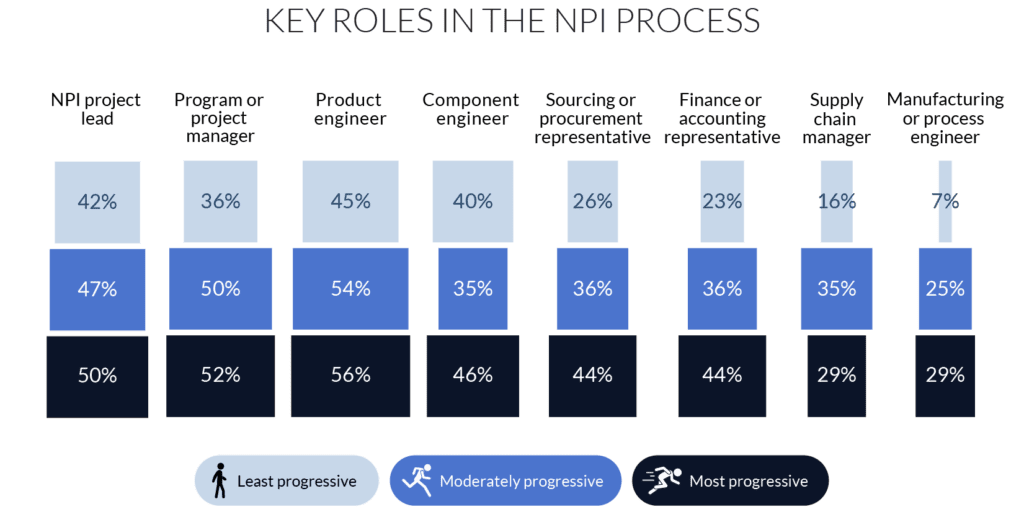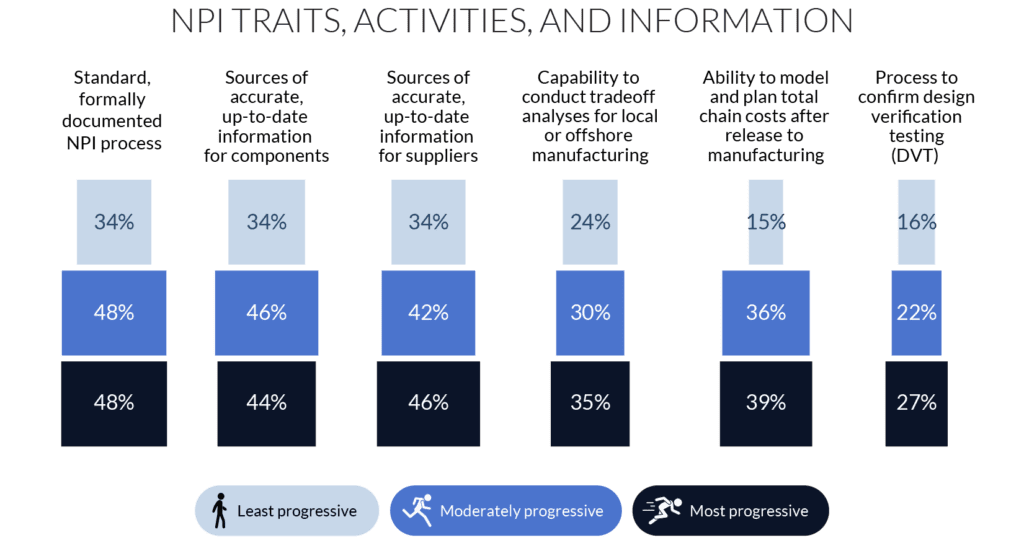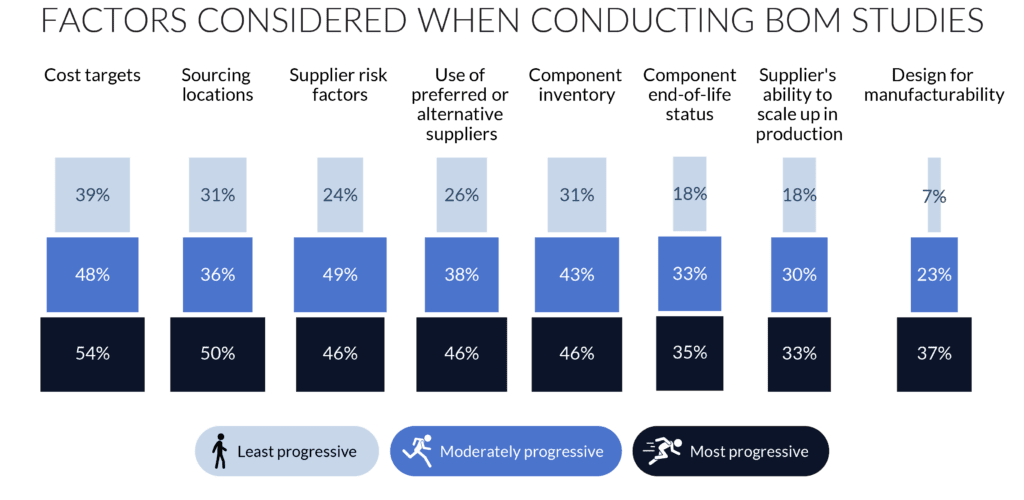- Solutions
ENTERPRISE SOLUTIONS
Infuse new product development with real-time intelligenceEnable the continuous optimization of direct materials sourcingOptimize quote responses to increase margins.DIGITAL CUSTOMER ENGAGEMENT
Drive your procurement strategy with predictive commodity forecasts.Gain visibility into design and sourcing activity on a global scale.Reach a worldwide network of electronics industry professionals.SOLUTIONS FOR
Smarter decisions start with a better BOMRethink your approach to strategic sourcingExecute powerful strategies faster than ever - Industries

Compare your last six months of component costs to market and contracted pricing.

- Platform
- Why Supplyframe
- Resources
Editor’s Note: This is the fifth article in a series discussing the findings from a NPI and Sourcing Study, done in partnership with Lifecycle Insights. The content below was produced by Lifecycle Insights. Click here to see the series overview.
Manufacturing organizations rely on the NPI checks and activities to take a product from an idea to its final form. This process has always been a challenge, but the increasing complexity of today’s products makes it even more unwieldy. Yet, Lifecycle Insights’ NPI and Sourcing Study findings revealed that many organizations are meeting these challenges head-on and reaping the rewards. They have found ways to leverage strategic DX for NPI initiatives to launch and deliver more products on time while also meeting NPI success criteria.
Here, we discuss the tactical enablers that companies are executing to realize these benefits. They include:
- more extensive participation in the NPI process;
- more activities and more accurate information in the NPI process; and
- more exhaustive factors in BOM trade studies.
More Extensive Participation in the NPI Process
The NPI process, by its very nature, is multi-functional. Getting the most out of this process requires participation by many stakeholders from various departments who must perform their own due diligence activities. The benchmarking analysis demonstrated that both length and breadth of DX for NPI efforts affect an organization’s performance. But responses in the NPI and Sourcing Study also highlight other key differences between the most progressive organizations and the other respondent groups.

Figure 5: The most progressive involve more roles from more functional departments in their NPI processes, collecting and providing a broader set of insights on NPI decisions.
One notable finding is that the most progressive organizations incorporate more roles in the NPI process. At first, this result may seem counterintuitive. But these roles are representatives that provide oversight. When NPI project leads, project managers, and program managers are involved in the process, they can synchronize their efforts, making it easier to stay on schedule while still satisfying NPI criteria.
The most progressive companies also include product and component engineers, who help to integrate broader enterprise concerns beyond form, fit, and function. As a result, the team makes more informed design decisions and is more successful at addressing and satisfying all NPI criteria.
The most progressive organizations are almost twice as likely to include individuals from sourcing and procurement, too. You can see the advantage: The way a company sources components for a complex product can dramatically impact how well it meets NPI criteria. By involving these roles in the NPI process, the most progressive organizations have early visibility into any potential issues.
The same holds true for finance and accounting. The most progressive organizations are twice as likely as their least progressive counterparts to involve these roles in NPI. But the financial perspective on the product can guide companies in making cost-related decisions during product development.
Finally, some of the most progressive organizations also include supply chain managers and even manufacturing and process engineers in the NPI process. These roles appear in the NPI process less commonly than other stakeholder roles, but their input helps keep costs down and avoid delays.
By supporting more extensive participation in the NPI process, the most progressive organizations can satisfy more of their NPI criteria. It makes sense: Different stakeholders can assess the product and BOM from their own unique perspectives. Their feedback facilitates more informed decisions and helps organizations develop corrective action plans before any mistakes or issues become too costly.
More Activities and Accurate Information in the NPI Process
The most progressive organizations’ NPI processes don’t just include a wide range of participants. They also support a broad set of activities and information. This puts companies in a better position to launch or deliver on time and meet all NPI criteria in the process.

Figure 6: The most progressive leverage sources of accurate, up-to-date information for components and suppliers as part of their NPI process. They also conduct trade-off studies for local versus offshore manufacturing, model and plan total supply chain costs, and design verification testing.
Findings from Lifecycle Insights’ NPI and Sourcing Study show that the most progressive organizations are more likely to execute many more activities as part of their NPI process. These can include trade-off analyses, modeling of total supply chain costs, and design verification testing (DVT).
These progressive organizations are also more likely to utilize sources of accurate, up-to-date information for both components and suppliers. This is a crucial enabler in the NPI process. Access to the most accurate information enables smart, informed decisions that allow organizations to stay on schedule and satisfy NPI criteria.
The most progressive also include other activities that empower more informed decision-making in their NPI processes. These include conducting trade-off analyses for local or offshore manufacturing and modeling supply chain costs after release. These help stakeholders better forecast all those “what-if” scenarios that can later affect launch, delivery, or NPI criteria satisfaction.
DVT also allows companies to certify that a new product performs as expected, satisfies requirements, and addresses NPI criteria. Formalized and standardized processes on this front ensure reproducible methods that help these most progressive companies launch or deliver on time.
It is clear that companies benefit from more accurate sources of new product information and standardized activities to support the NPI process. With these in place, organizations are more successful at meeting launch or delivery dates and satisfying NPI criteria.
More Exhaustive Factors in BOM Trade Studies
Products invariably have competing or conflicting constraints. The key to mitigating such conflicts is to be aware of them and then work through them with trade studies. The study found that the most progressive organizations assess and compare more criteria in trade studies than the other groups.
Cost is always a crucial factor to assess through development. Each component or purchased assembly has associated cost targets to maximize profit. Including this in trade studies is vital. Sourcing location is also important, especially for organizations that manufacture and deliver products to different geographical regions. Assessing local availability of components is critical to keep costs down and to determine whether products can be made in different areas.
Trade studies should also investigate supplier risk factors, use of preferred suppliers, and a supplier’s ability to scale up in production. These factors directly affect the selection of suppliers—and whether products can ultimately be produced.
Finally, the most progressive also evaluate designing for manufacturability, which can affect the cost and timeliness of component or product delivery.

Figure 7: The most progressive include more factors in their BOM trade studies. This offers more insight into the implications of alternatives, resulting in more informed decisions.
As revealed in the study, the most progressive organizations consider a much broader range of factors in BOM trade studies. Consequently, they enjoy a more comprehensive understanding of the impact of different decisions, whether those decisions influence financial, sourcing, manufacturing, or other aspects of product development. The end result is that the most progressive organizations have the necessary data to make more informed decisions which, in turn, helps them stay on schedule and satisfy NPI criteria.
Enabler Takeaways
Findings from Lifecycle Insights’ NPI and Sourcing Study show that the most progressive organizations benefit from the length and breadth of their DX for NPI investments, and from the specific capabilities that those investments enable. Their NPI processes include:
- more participants from various departments;
- more activities and accurate, up-to-date information; and
- a more exhaustive list of factors to evaluate in BOM trade studies.
By investing in initiatives that support these tactical enablers, the most progressive organizations launch and deliver more new products on time and meet more NPI criteria. It’s a win/win situation.



